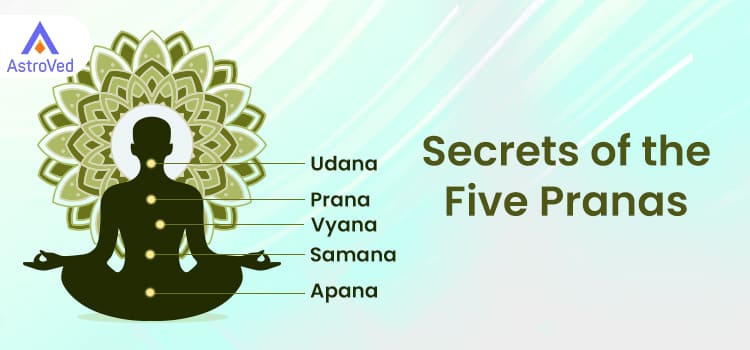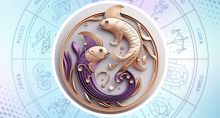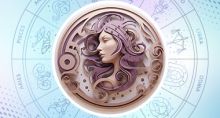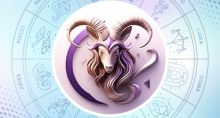Secrets of the 5 Pranas
Prana means many things, like breath to the energy of consciousness. It is the basic life force and the master form of all energy that works on the level of mind, life, and body. The whole universe is a manifestation of Prana, the original creative power. Kundalini Shakti, the serpent power within us that transforms consciousness, emerges from the awakened Prana.
A human being has 5 koshas or sheaths. They range from the physical to subtle and causal principles:
∙ Annamaya kosha – food – physical – the five elements
∙ Pranamaya kosha – breath – vital – the five pranas, subtle body energies, motor organs
∙ Manomaya kosha – impressions – outer mind – sense organs, deeper imagination, astral
∙ Vijnanamaya kosha – ideas – intelligence – directed mental activity, deeper wisdom
∙ Anandamaya kosha – experiences – memory, subliminal and superconscious mind, repository of karmas, causal
Pranamaya Kosha
The Pranamaya Kosha represents our vital life energies. It mediates between the body and the mind’s 3 sheaths (outer mind, intelligence, and inner mind) and acts on both levels. It meditates between the 5 gross elements and the 5 sensory impressions.
Our vital energies are related to survival, reproduction, movement and self-expression, and are mainly connected to the 5 motor organs (excretory, urino-genital, feet, hands, and vocal organ).
The vital body dominates most of us. Its deep-seated urges are essential to keep us alive. It is the abode of the vital or subconscious ego, which contains the various fears, desires, and attachments which trouble us. We spend most of our time seeking enjoyment through the vital body in the form of sensory pleasures and acquisition of material objects.
A person who has a strong, vital nature will impress their personality upon the world. Those whose vital nature is weak do not have the power to accomplish much and have a negligible effect on life, usually having a subordinate position. People with strong and egoistic vitals run the world, and those with weak vitals follow them. A strong egoistic vital is a tremendous obstacle to the spiritual path.
A strong vital or Pranamaya kosha, however, is essential for the spiritual path as well, but it differs from the egoistic or desire-oriented vital. It gets its strength not from personal power but from surrender to the divine and its immense energy. If we lack a strong spiritual vital, we will not have the power to do our practices and may fall under worldly influences.
Prana exists in all five koshas in various forms and is rooted in the Atman or inner Self. This Atmic Prana is the highest form of Prana and bestows healing and immortality of consciousness.
The Five Pranas
Pranamaya kosha comprises the five Pranas. The one primary Prana divides into 5 kinds as per its movement and direction. It is very important in Ayurvedic medicine and yogic thought.
Prana
Prana, which means the “forward moving air,” literally, moves inward and rules the reception of all types from eating food, drinking water, inhaling air, to receiving sensory impressions and mental experiences. It has a propulsive nature. It sets things in motion and guides them. It gives us the basic energy that drives us in life, and connects to the Purusha (the higher Self within) ulltimately.
Apana
Apana literally means the “air that moves away.” It moves downward and outward and rules all forms of elimination and reproduction (which too has a downward movement). It rules the elimination of stools and the urine, the expelling of the fetus, semen, and menstrual fluid, and also the elimination of carbon dioxide through the breath. On a deeper level it governs the elimination of negative sensory, emotional and mental experiences. On all levels, it is the basis of our immune function.
Udana
Udana literally means “upward moving air.” It moves upward and represents the qualitative or transformative movements of the life-energy. It rules growth of the body, speech, effort, the ability to stand, speech, enthusiasm, and will. It is the main positive energy in our life. Through it, we can develop our subtle and causal bodies, and our consciousness can evolve.
Samana
Samana literally means the “balancing air.” It moves from the periphery to the center. This happens through a churning and discerning action. It helps digestion on all levels. In the gastrointestinal tract, it works to digest food. In the lungs, it digests air or absorbs oxygen. In the mind, it homogenizes and digests experiences, whether mental, sensory, or emotional. At a higher yogic level, it gives us the balance to take us into Samadhi, which is the yogic state of unity consciousness.
Vyana
Vyana literally means the “outward moving air.” It moves from the center to the periphery and rules circulation on all levels. It moves water, food, and oxygen throughout the body. It also keeps our thoughts and emotions circulating in the mind. It imparts movement and gives strength, thereby helping all the other Pranas in their work. On a higher level it enables our energies to expand into the infinite.

The five Pranas are processes and energies that occur on several levels in the mind and body. However, it is possible to localize them in a few important ways relative to the physical body.
∙ Prana Vayu rules the movement of energy from the head down to the navel, which forms the Pranic center in the physical body.
∙ Apana Vayu rules the movement of energy from the navel down to the root chakra.
∙ Samana Vayu rules the movement of energy from the entire body back to the navel.
∙ Vyana Vayu rules the movement of energy out from the navel throughout the body.
∙ Udana rules the movement of energy from the navel up to the head.
To summarize, we can say that Prana rules the intake of substances. Samana rules their absorption. Vyana rules the circulation of nutrients. Udana rules the release of positive energy, and Apana rules the elimination of waste materials.
This is similar to how a machine works. Prana supplies the fuel, Samana transforms it into energy, and Vyana circulates it to the work sites. Apana expels the waste materials, which are the byproducts of the conversion process. Udana rules the positive energy created in this process and determines the work that the machine can do.
We will enjoy good health and well-being if our Pranas are in harmony. When there is an imbalance in one Prana, the others also become imbalanced as they are all connected. In general, Prana and Udana work opposite to Apana. The first two are the forces of energization, and the third is the force of elimination. Likewise, Vyana and Samana are opposites. One is expansion and the other is contraction.
How Prana Creates Our Physical Body
Sans Prana, the physical body is just a lump of clay. From this gelatinous mass, Prana creates limbs and organs. To do this, it creates various channels or Nadis. Through these, it operates and energizes gross matter into different tissues and organs.
It is Prana Vayu that creates the openings and channels in the brain and head and down to the heart. The head has 7 openings - 2 eyes, 2 ears, 2 nostrils, and the mouth. These are the 7 Pranas or 7 Rishis in Vedic thought. Udana aids Prana in creating the openings in the body’s upper part, especially those of the mouth and vocal organs. The mouth is the main opening in the head as well as the entire body. The entire physical body is like an extension of the mouth, which is the most important organ for physical activity, eating, and self-expression.
Apana Vayu creates the openings in the body’s lower part - the urino-genital and excretory systems. Samana Vayu creates the openings in the body’s middle part - the digestive system, centered in the navel, and which opens out the channels of the intestines and the organs, including the liver and pancreas, which secrete into it. Vyana Vayu creates the channels leading to the body’s peripheral parts - the arms and legs. It creates the arteries, veins, joints, sinews, muscles, and bones.
In sum, Samana Vayu creates the body’s trunk (dominated by the gastrointestinal tract), and Vyana Vayu creates the limbs. Prana and Udana create the upper bodily orifices, and Apana creates those below.
But Prana does not just on a physical level. The navel is the key vital center for the physical body. The main center for the Pranamaya Kosha is the heart, while the head is the key center for Manomaya Kosha.
Prana and the Mind
The mind has its energy and Prana, too, deriving from food, breath and impressions externally.
∙ Prana rules the intake of sensory impressions.
∙ Samana rules mental digestion.
∙ Vyana rules mental circulation.
∙ Apana rules the elimination of negative emotions and toxic ideas.
∙ Udana rules positive mental energy, strength, and enthusiasm.
The 5 Pranas work on the mind in slightly different ways than they do on the physical body. They act more on a subtle level.
Psychologically, Prana rules our receptivity to positive sources of feeling, nourishment, and knowledge through the senses and mind. When it is deranged, we experience wrong desires and insatiable cravings. We become imbalanced, misguided, and misdirected.
Apana rules our ability to expel negative thoughts and emotions. When deranged, it can cause depression, and we become clogged up with undigested experiences that burden us and make us weak, fearful, and suppressed.
Samana Vayu offers nourishment, contentment, and balance in the mind. When deranged, it gives a tendency to cling to things and possessiveness.
Vyana Vayu is responsible for free movement and independence in the mind. When deranged it can cause isolation, hatred, and alienation. We fail to unite with others or stay connected in what we do.
Udana offers joy and enthusiasm. It can awaken our higher spiritual and creative potentials. When deranged, it causes pride and arrogance. We try to go too high and lose connection with our roots.
Higher Yogic Aspects of the 5 Pranas
In yogic practice, the Pranas have many special actions. Spiritually, Samana Vayu rules the space within the heart, called antar hridyakasha, in which the true Self, the Atman resides as a fire with 7 flames, and rules antariksha, the central internal space. Samana uses fuel to regulate Agni, which must burn evenly. Without Samana’s peace and balance, it is not possible to return to the core of our being or concentrate the mind.
Vyana rules the movement of Prana through the Nadis. It keeps them clear, open, and even in their functioning. Apana shields us from negative astral influences and fake teachers. Prana provides us with the aspiration for spiritual development.
Udana rules our growth in consciousness. It takes the mind into the state of sleep and realms of the after death. Udana also rules the movement up the sushumna, including the Kundalini’s awakening.
The mind moves with Udana Vayu, which takes us to the states of deep sleep and dreams. Once death occurs, it leads the soul to the astral and causal planes. This is the most important Prana for spiritual growth and also rules Mantra.
When we do Yoga the subtle aspects of the Pranas start to awaken. This can cause some unusual movements of energy in the mind and body. This includes the occurrence of spontaneous movements or kriyas. We could feel new expanses of energy (subtle Vyana), immense peace (subtle Samana), lightness or levitation (subtle Udana), stability and deep groundedness (subtle Apana), or just enhanced vitality and sensitivity (subtle Prana).
Working On Prana
Proper nutrition helps increase Prana on the physical level. It also requires proper elimination. In Ayurveda, Prana from the food is absorbed in the large intestine, especially in the upper two-thirds of the organ, which is not just an organ of elimination. Hence, Apana Vayu is the most important Prana for ensuring physical health and treating Vata dosha.
Pranayama
Yogic breathing exercises or Pranayama is the main method for working on Prana. Yoga lays emphasis on Deha shuddhi, or purification of the body, and chitta shuddhi, or purification of the mind, as the means to Self-realization. Hence, Yoga stresses the importance of following a vegetarian diet that is rich in Prana or foods full of the life force as well as a mind rooted in ethical values like honesty and non-violence. A toxic, impure, or disturbed body and mind will not be able to realize the higher Self. Prana is key to purifying both body and mind. The main method for this is Nadi-shodhana or purification of the nadis/channels through which Prana flows.
While all Pranayama helps purify, the most important is the alternate nostril breathing, which helps balance the right and left Prana currents. According to Yoga, the body and its channels have a right or left predominance. The body’s right side is solar in nature and masculine. The left side is lunar in nature and feminine. The left/lunar nadi is dominated by Kapha or water and boosts energy on the left side of the body. It enables activities like rest, sleep, and relaxation. The right or solar nadi is dominant in Pitta or fire and tends to increase energy on the right side. It enables activities like work, digestion, and concentration.
Regular alternate nostril breathing is the most important technique to keep our Pranas or energies balanced. It helps create the unitary Prana essential to sustain unitary awareness.
Another technique involves uniting Prana and Apana. Apana is aligned with the force of gravity and tends to move downward. This leads to disease and death and the downward movement of consciousness. But Prana disperses upward through the senses and mind, as it is the opening to the energies above.
Yogic practices involve bringing up Apana. Prana has to be brought down to unite with Apana. This helps balance and unite all the Pranas. When this happens, the inner fire or Kundalini is enkindled in the navel region. The practice of Mula Bandha is important in this regard. The aim is to balance the outer and physical pranas and awaken the higher and inner pranas associated with deeper awareness.
Mantra and Meditation
The Pranas or energies in the mind can also be dealt with directly. Color and sound (music) are two important ways to direct energy in the mind. The best method is Mantra, especially single syllable or Bija mantras like OM. They can generate vibrations (nada) that direct energy into the subconscious.
Meditation involves creating space in the mind. It helps create more Prana in the mind. During meditation, the mind is silent and receptive, and a new energy is born within it that effects great transformations.
All the paths of Yoga have their basis in Prana. Bhakti Yoga (Yoga of Devotion) creates Pranic transformation by merging us with the Divine Will and Divine Prana. Karma Yoga or service is also based upon alignment with the Divine Will. This can give us more Prana to act outwardly and for inner development.
Classical Yoga/Raja Yoga aims to control mental activities (Chitta-vrittis). The mind’s vibration (Citta-spanda) follows Prana’s vibration (Prana-spanda). Thus, Pranayama helps control one’s mind. It also helps control the senses (Pratyahara) as it pulls our awareness inward from the senses. Hatha Yoga is mainly concerned with Prana, and even Asana is an expression of Prana. Many great Yogis learned Asana through the power of their awakened Prana and not through mechanical practice.
Even Jnana Yoga (Yoga of Knowledge) depends on a strong will and concentration. Unless the Udana Vayu is well-developed, it cannot succeed. In Jnana Yoga, the Prana of inquiry has to be created to inquire into our true nature mentally and in all our daily activities. Inquiry should occur through Prana and not just through the outer mind.
The Vedas say that we are all under Prana’s control. Prana is the Sun that provides life and light to all and lives within the heart as the Self of all creatures.




















